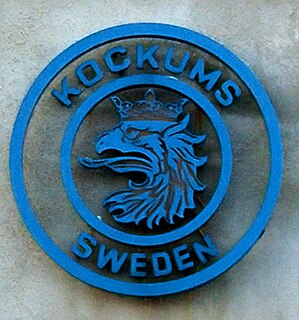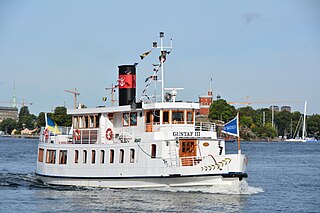
A survey vessel is any type of ship or boat that is used for underwater surveys, usually to collect data for mapping or planning underwater construction or mineral extraction. It is a type of research vessel, and may be designed for the purpose, modified for the purpose or temporarily put into the service as a vessel of opportunity, and may be crewed, remotely operated, or autonomous. The size and equipment vary to suit the task and availability.

Saab Kockums AB is a shipyard headquartered in Malmö, Sweden, owned by the Swedish defence company Saab Group. Saab Kockums AB is further operational in Muskö, Docksta, and Karlskrona. While having a history of civil vessel construction, Kockums' most renowned activity is the fabrication of military corvettes and submarines.

The Gotland-class submarines of the Swedish Navy are modern diesel-electric submarines, which were designed and built by the Kockums shipyard in Sweden. They are the first submarines in the world to feature a Stirling engine air-independent propulsion (AIP) system, which extends their underwater endurance from a few days to weeks. This capability had previously only been available with nuclear-powered submarines.

The Protector unmanned surface vehicle (USV) was developed by the Israeli Rafael Advanced Defense Systems in response to emerging terrorist threats against maritime assets such as the USS Cole bombing, and is the first operational combat USV in service. It is fitted with a Mini Typhoon Weapon Station. In 2005, it was deployed by the Singapore Navy to support coalition forces in the Persian Gulf, and was later deployed for anti-piracy duties in the Gulf of Aden. In 2012, Rafael announced that they were building a larger version of the Protector, that would have a greater range, and be equipped with a wider range of weaponry.

Unmanned Surface Vehicles are boats or ships that operate on the surface of the water without a crew. USVs operate with various levels of autonomy, from simple remote control, to autonomous COLREGs compliant navigation.

The Typhoon is a type of remote weapon station manufactured by Rafael Advanced Defense Systems of Israel, and it shares similar design principles and common technologies with Samson Remote Controlled Weapon Station, a land-based system manufactured by the same developer. Like Samson RCWS, Typhoon is also multi-configurable.

UAPS20 is an autopilot system that can be installed on an RHIB boat to obtain a low-cost unmanned surface vehicle.
The Piranha Unmanned Surface Vessel is a watercraft developed by Zyvex Marine in 2010. The boat is 54 feet in length and weighs just 8,000 lbs. The Piranha is the first USV to utilize a lightweight carbon-nanotube enhanced composite material called Arovex, which allows the watercraft to weigh "significantly less" than any other USV.
Liquid Robotics is an American marine robotics corporation that designs, manufactures and sells the Wave Glider, a wave and solar powered unmanned surface vehicle (USV). The Wave Glider harvests energy from ocean waves for propulsion. With this energy source, Wave Gliders can spend many months at a time at sea, collecting and transmitting ocean data.

The Fleet-class unmanned surface vessel, also called the Common Unmanned Surface Vessel (CUSV) and later the Mine Countermeasures Unmanned Surface Vehicle, is an unmanned surface vessel designed for the United States Navy to be deployed from Freedom and Independence-class littoral combat ships and intended to conduct mine and anti-submarine warfare missions. As of 2012 four units of the class have been built; the first was delivered to the U.S. Navy in 2008.
Silver Marlin is an Israeli unmanned surface vehicle (USV) designed for maritime patrol missions. It is equipped with a 7.62mm remote-controlled stabilized weapon station as well as observation and satellite communication systems. It has an endurance of 24–36 hours, with a primary mission of reconnaissance, surveillance, force protection/anti-terror, anti-surface and anti-mine warfare, search and rescue, port and waterway patrol, battle damage assessment, pollution detection and treatment as well as electronic warfare.
USV Maxlimer is a semi-autonomous, remotely controlled unmanned surface vehicle (USV) owned and operated by the British company SEA-KIT International. She was the winning entry in the Shell Ocean Discovery X Prize competition, and subsequently has been used as a proof-of-concept vessel for uncrewed, over-the-horizon offshore operations.
The JARI USV is an unmanned surface vehicle developed by the China Shipbuilding Industry Corporation (CSIC), specifically between its No. 716 Research Institute, the Jiangsu Automation Research Institute (JARI), and No. 702 Research Institute, China Ship Scientific Research Centre (CSRRC). The unmanned warship is designed for potential use for the People's Liberation Army Navy and export customers.

MV Gustaf III is a steamship that still operates in Sweden today as of 2021.
Jinghai USVs are a series unmanned surface vehicles developed by Shanghai University, and as end of 2021, a total of eight models have been identified:
Yuzhou USVs are various USV developed by Chinese Zhuhai Yunzhou Intelligence Science & Technology Corporation (云洲智能科技), most of which have already entered service with Chinese military, paramilitary, police & governmental agencies:
HUST USVs are unmanned surface vehicles developed by Huazhong University of Science and Technology (HUST), and by end of 2021, two USVs have been revealed to be in service:
JUST unmanned vehicles are uncrewed vehicles developed by Jiangsu University of Science and Technology, and these unmanned vehicles include both unmanned surface vehicle (USV)s and unmanned underwater vehicles (UUV)s
Ostar unmanned vehicles are uncrewed vehicles. They are developed in the People's Republic of China (PRC) by Ostar, most of which are in service with various Chinese governmental agencies/departments, and government-owned enterprises.








